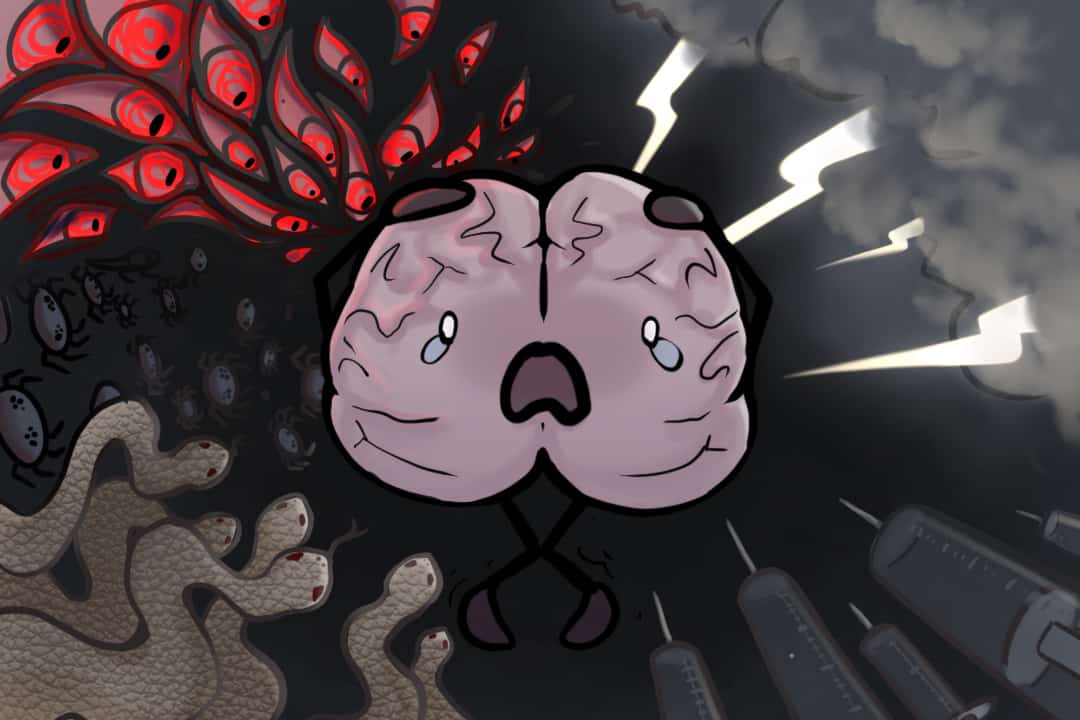With the Halloween season in full swing, horror movies, haunted houses, and jumpscares are terrifying us all. But have you wondered how we even feel fear? How is it that your brain knows what to be scared of, and what goes on in your brain when you have a flight-or-fight response?
The way different brain systems interact in the moment in response to a threatening context has been a topic of research for many neuroscientists and psychologists. Fear is described as a motivational state caused by certain stimuli that make us act defensively or escape the threat, that is, fight or flight.
When you walk around the corner at a haunted house and a ‘ghost’ jumps out at you, your brain considers those rapid movements and loud noises enough stimuli to trigger your fear response, making you scream or freeze up.
At their core, fearful experiences have a physical or spatial context; all threatening experiences have occurred at a certain place and moment in time. Our brains use these contexts and memories to inform future expressions of fear.
To study the significance of context in experiencing fear, some labs use a technique known as fear conditioning. Fear conditioning pairs neutral and aversive stimuli repeatedly over time, which can result in fearful responses to the neutral stimulus — a stimulus that previously would have elicited no response in the subject. Accordingly, certain contexts can elicit fear if previously paired with something aversive.
The technique of fear conditioning is a valuable behavioural paradigm for understanding the neural basis of human psychiatric disorders related to fear and anxiety.
Studies using this technique and others identified the hippocampus as central to context representation and memory formation. The two-process theory suggests that both the hippocampus and the amygdala are involved in contextual fears, with the former involved in storing the context of the traumatic event and the latter in storing the experience. When encountering a threatening event, the co-activation of these two brain areas drives physiological and psychological responses to fear, such as increased respiration, elevated heart rate, release of the stress hormone, and feelings of dread and anxiety.
When faced with a situation similar to a threatening context experienced previously, the hippocampus decides between processes called pattern completion and pattern separation to determine an outcome.
“If a context is sufficiently similar to the memory of the threatening context, the hippocampus will ‘autocomplete’ and retrieve the memory of the threatening context,” explained Robert Rozeske, an assistant professor at the University of Toronto studying neuronal mechanisms of fear and anxiety, in an email to The Varsity. “If a context only has minor similarities to the memory [of] the threatening context, the hippocampus classifies that context as different and thus separates the current context from the threatening context [in] memory.”
He further explained that in instances where the context is ambiguous, the prefrontal cortex is hypothesized to be essential in removing ambiguity regarding the context. This process highlights the importance of different brain regions working together to support the same goal: making sense of fear.
One issue these systems and fear responses face is overgeneralization. While the brain is largely efficient in predicting outcomes of current situations based on past experiences on a daily basis, this efficiency can give rise to overgeneralization. “When a sufficiently intense trauma occurs, an individual in an otherwise non-threatening environment may generalize their current situation to closely resemble a traumatic memory,” wrote Rozeske. Post-traumatic stress disorder is one such consequence, theorized to occur due to an impairment in a circuit consisting of the hippocampus and the prefrontal cortex for context processing.
Using rodents as model organisms, Rozeske is interested in the dynamic expression of emotional behaviours by leveraging the power of techniques like optogenetics — the use of light to activate or deactivate neurons — to decipher whether the activity of certain neurons is required for the expression of fear behaviour. His recent work found that the prefrontal cortex in mice represents contexts differently after the mice undergo context fear conditioning that transforms these contexts from neutral to threatening and vice versa. His team has also identified a circuit that is activated when mice transition from a threatening to neutral context. The circuit contains the prefrontal cortex and a midbrain structure called the periaqueductal gray.
Future studies on fear should explore how we experience fear indirectly and how the brain perceives and reacts to fear expressed by others. Understanding these mechanisms will provide us with a better understanding of fear and social expressions in general.
So the next time you’re in a haunted house, wandering through the unknown when someone runs at you with a saw, you’ll know exactly why you feel like sprinting away at full speed!


